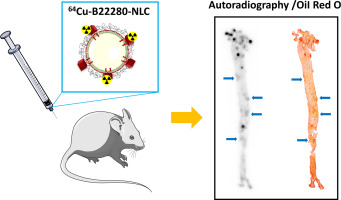当前位置:
X-MOL 学术
›
Nanomed. Nanotech. Biol. Med.
›
论文详情
Our official English website, www.x-mol.net, welcomes your
feedback! (Note: you will need to create a separate account there.)
Nanostructured lipid carriers accumulate in atherosclerotic plaques of ApoE-/- mice.
Nanomedicine: Nanotechnology, Biology and Medicine ( IF 4.2 ) Pub Date : 2020-01-23 , DOI: 10.1016/j.nano.2020.102157 Jonathan Vigne 1 , Claudia Cabella 2 , László Dézsi 3 , Emilie Rustique 4 , Anne-Claude Couffin 4 , Rachida Aid 5 , Nadège Anizan 5 , Cédric Chauvierre 6 , Didier Letourneur 6 , Dominique Le Guludec 1 , François Rouzet 1 , Fabien Hyafil 1 , Tamás Mészáros 3 , Tamás Fülöp 3 , János Szebeni 3 , Alessia Cordaro 2 , Paolo Oliva 2 , Véronique Mourier 4 , Isabelle Texier 4
Nanomedicine: Nanotechnology, Biology and Medicine ( IF 4.2 ) Pub Date : 2020-01-23 , DOI: 10.1016/j.nano.2020.102157 Jonathan Vigne 1 , Claudia Cabella 2 , László Dézsi 3 , Emilie Rustique 4 , Anne-Claude Couffin 4 , Rachida Aid 5 , Nadège Anizan 5 , Cédric Chauvierre 6 , Didier Letourneur 6 , Dominique Le Guludec 1 , François Rouzet 1 , Fabien Hyafil 1 , Tamás Mészáros 3 , Tamás Fülöp 3 , János Szebeni 3 , Alessia Cordaro 2 , Paolo Oliva 2 , Véronique Mourier 4 , Isabelle Texier 4
Affiliation

|
Nanostructured lipid carriers (NLC) might represent an interesting approach for the identification and targeting of rupture-prone atherosclerotic plaques. In this study, we evaluated the biodistribution, targeting ability and safety of 64Cu-fonctionalized NLC in atherosclerotic mice. 64Cu-chelating-NLC (51.8±3.1 nm diameter) with low dispersity index (0.066±0.016) were produced by high pressure homogenization at tens-of-grams scale. 24 h after injection of 64Cu-chelated particles in ApoE-/- mice, focal regions of the aorta showed accumulation of particles on autoradiography that colocalized with Oil Red O lipid mapping. Signal intensity was significantly greater in aortas isolated from ApoE-/- mice compared to wild type (WT) control (8.95 [7.58, 10.16]×108 vs 4.59 [3.11, 5.03]×108 QL/mm2, P < 0.05). Moreover, NLC seemed safe in relevant biocompatibility studies. NLC could constitute an interesting platform with high clinical translation potential for targeted delivery and imaging purposes in atherosclerosis.
中文翻译:

纳米结构脂质载体在ApoE-/-小鼠的动脉粥样硬化斑块中积累。
纳米结构脂质载体(NLC)可能是用于识别和靶向易破裂动脉粥样硬化斑块的有趣方法。在这项研究中,我们评估了64Cu功能化NLC在动脉粥样硬化小鼠中的生物分布,靶向能力和安全性。通过数十克规模的高压均质化生产低分散指数(0.066±0.016)的64Cu-螯合-NLC(直径51.8±3.1 nm)。在ApoE-/-小鼠中注射64Cu螯合的颗粒后24小时,主动脉的局灶区域在放射自显影中显示了与油红O脂质图共定位的颗粒堆积。与野生型(WT)对照相比,从ApoE-/-小鼠分离的主动脉的信号强度显着更高(8.95 [7.58,10.16]×108 vs 4.59 [3.11,5.03]×108 QL / mm2,P <0.05)。此外,在相关的生物相容性研究中,NLC似乎是安全的。NLC可以构成一个有趣的平台,具有很高的临床翻译潜力,可用于动脉粥样硬化的靶向递送和成像。
更新日期:2020-01-24
中文翻译:

纳米结构脂质载体在ApoE-/-小鼠的动脉粥样硬化斑块中积累。
纳米结构脂质载体(NLC)可能是用于识别和靶向易破裂动脉粥样硬化斑块的有趣方法。在这项研究中,我们评估了64Cu功能化NLC在动脉粥样硬化小鼠中的生物分布,靶向能力和安全性。通过数十克规模的高压均质化生产低分散指数(0.066±0.016)的64Cu-螯合-NLC(直径51.8±3.1 nm)。在ApoE-/-小鼠中注射64Cu螯合的颗粒后24小时,主动脉的局灶区域在放射自显影中显示了与油红O脂质图共定位的颗粒堆积。与野生型(WT)对照相比,从ApoE-/-小鼠分离的主动脉的信号强度显着更高(8.95 [7.58,10.16]×108 vs 4.59 [3.11,5.03]×108 QL / mm2,P <0.05)。此外,在相关的生物相容性研究中,NLC似乎是安全的。NLC可以构成一个有趣的平台,具有很高的临床翻译潜力,可用于动脉粥样硬化的靶向递送和成像。











































 京公网安备 11010802027423号
京公网安备 11010802027423号